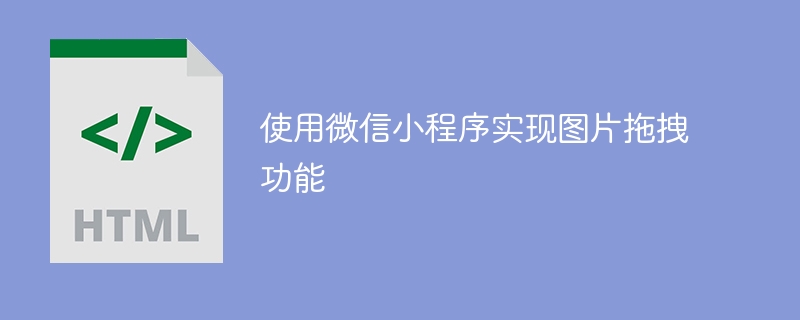Home > Article > Web Front-end > Use WeChat applet to implement image drag and drop function

Use WeChat mini programs to implement image drag and drop functions
Introduction:
With the popularity of WeChat mini programs, more developers have begun to explore the use of mini programs Various functions and features. Among them, implementing the image drag and drop function is a common requirement. This article will introduce how to use the API and components of the WeChat applet to achieve the effect of dragging pictures, and provide specific code examples.
1. Design Idea
The basic idea to implement the image dragging function is as follows:
2. Code Implementation
In the .wxml file of the mini program, add a
<view class="img-container" style="width:{{imgWidth}}px; height:{{imgHeight}}px;left:{{left}}px;top:{{top}}px;background-image:url({{imgUrl}});background-size:cover;" bindtouchstart="touchStart" bindtouchmove="touchMove" bindtouchend="touchEnd"></view>In the corresponding page context of the .wxml file, define relevant data bindings and functions, and Initialization parameters:
data: {
startX: 0,
startY: 0,
left: 0,
top: 0,
imgWidth: 200,
imgHeight: 200,
imgUrl: '图片地址'
},
touchStart: function (e) {
this.setData({
startX: e.touches[0].clientX,
startY: e.touches[0].clientY
})
},
touchMove: function (e) {
var that = this,
startX = that.data.startX,
startY = that.data.startY,
moveX = e.touches[0].clientX,
moveY = e.touches[0].clientY,
left = that.data.left,
top = that.data.top;
var disX = moveX - startX,
disY = moveY - startY;
that.setData({
left: left + disX,
top: top + disY
})
},
touchEnd: function () {
// do something...
}In the .wxss file, set the initial style of the image container:
.img-container {
position: absolute;
transition: none;
}In the .js file of the mini program , add logic code to handle the logic of finger touch events.
Page({
data: {
startX: 0,
startY: 0,
left: 0,
top: 0,
imgWidth: 200,
imgHeight: 200,
imgUrl: '图片地址'
},
touchStart: function (e) {
this.setData({
startX: e.touches[0].clientX,
startY: e.touches[0].clientY
})
},
touchMove: function (e) {
var that = this,
startX = that.data.startX,
startY = that.data.startY,
moveX = e.touches[0].clientX,
moveY = e.touches[0].clientY,
left = that.data.left,
top = that.data.top;
var disX = moveX - startX,
disY = moveY - startY;
that.setData({
left: left + disX,
top: top + disY
})
},
touchEnd: function () {
// do something...
}
})3. Function expansion
The above code implements the basic drag and drop function of images, but there are some additional functions that can be further improved to enhance the user experience.
Conclusion:
Through the above steps, we can easily implement the image drag and drop function in the WeChat applet. At the same time, we can also extend this feature to make it more powerful and practical. I hope this article is helpful to you, and I wish you go further and further on the road of WeChat mini program development.
The above is the detailed content of Use WeChat applet to implement image drag and drop function. For more information, please follow other related articles on the PHP Chinese website!